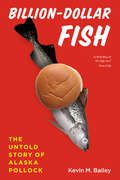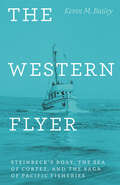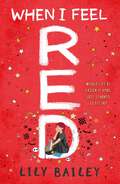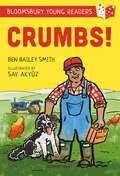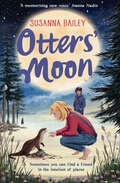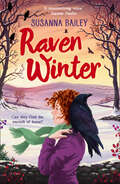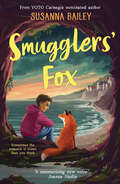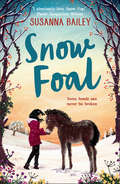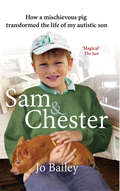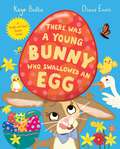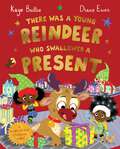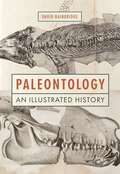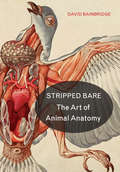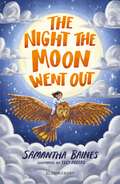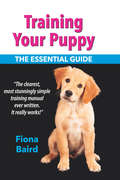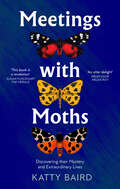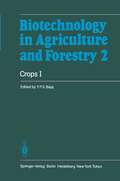- Table View
- List View
Billion-Dollar Fish: The Untold Story of Alaska Pollock
by Kevin M. BaileyAlaska pollock is everywhere. If you’re eating fish but you don’t know what kind it is, it’s almost certainly pollock. Prized for its generic fish taste, pollock masquerades as crab meat in california rolls and seafood salads, and it feeds millions as fish sticks in school cafeterias and Filet-O-Fish sandwiches at McDonald’s. That ubiquity has made pollock the most lucrative fish harvest in America—the fishery in the United States alone has an annual value of over one billion dollars. But even as the money rolls in, pollock is in trouble: in the last few years, the pollock population has declined by more than half, and some scientists are predicting the fishery’s eventual collapse. In Billion-Dollar Fish, Kevin M. Bailey combines his years of firsthand pollock research with a remarkable talent for storytelling to offer the first natural history of Alaska pollock. Crucial to understanding the pollock fishery, he shows, is recognizing what aspects of its natural history make pollock so very desirable to fish, while at the same time making it resilient, yet highly vulnerable to overfishing. Bailey delves into the science, politics, and economics surrounding Alaska pollock in the Bering Sea, detailing the development of the fishery, the various political machinations that have led to its current management, and, perhaps most important, its impending demise. He approaches his subject from multiple angles, bringing in the perspectives of fishermen, politicians, environmentalists, and biologists, and drawing on revealing interviews with players who range from Greenpeace activists to fishing industry lawyers. Seamlessly weaving the biology and ecology of pollock with the history and politics of the fishery, as well as Bailey’s own often raucous tales about life at sea, Billion-Dollar Fish is a book for every person interested in the troubled relationship between fish and humans, from the depths of the sea to the dinner plate.
Billion-Dollar Fish: The Untold Story of Alaska Pollock
by Kevin M. BaileyAlaska pollock is everywhere. If you’re eating fish but you don’t know what kind it is, it’s almost certainly pollock. Prized for its generic fish taste, pollock masquerades as crab meat in california rolls and seafood salads, and it feeds millions as fish sticks in school cafeterias and Filet-O-Fish sandwiches at McDonald’s. That ubiquity has made pollock the most lucrative fish harvest in America—the fishery in the United States alone has an annual value of over one billion dollars. But even as the money rolls in, pollock is in trouble: in the last few years, the pollock population has declined by more than half, and some scientists are predicting the fishery’s eventual collapse. In Billion-Dollar Fish, Kevin M. Bailey combines his years of firsthand pollock research with a remarkable talent for storytelling to offer the first natural history of Alaska pollock. Crucial to understanding the pollock fishery, he shows, is recognizing what aspects of its natural history make pollock so very desirable to fish, while at the same time making it resilient, yet highly vulnerable to overfishing. Bailey delves into the science, politics, and economics surrounding Alaska pollock in the Bering Sea, detailing the development of the fishery, the various political machinations that have led to its current management, and, perhaps most important, its impending demise. He approaches his subject from multiple angles, bringing in the perspectives of fishermen, politicians, environmentalists, and biologists, and drawing on revealing interviews with players who range from Greenpeace activists to fishing industry lawyers. Seamlessly weaving the biology and ecology of pollock with the history and politics of the fishery, as well as Bailey’s own often raucous tales about life at sea, Billion-Dollar Fish is a book for every person interested in the troubled relationship between fish and humans, from the depths of the sea to the dinner plate.
The Western Flyer: Steinbeck's Boat, the Sea of Cortez, and the Saga of Pacific Fisheries
by Kevin M. BaileyIn January 2010, the Gemini was moored in the Swinomish Slough on a Native American reservation near Anacortes, Washington. Unbeknownst to almost everyone, the rusted and dilapidated boat was in fact the most famous fishing vessel ever to have sailed: the original Western Flyer, immortalized in John Steinbeck’s nonfiction classic The Log from the Sea of Cortez. In this book, Kevin M. Bailey resurrects this forgotten witness to the changing tides of Pacific fisheries. He draws on the Steinbeck archives, interviews with family members of crew, and more than three decades of working in Pacific Northwest fisheries to trace the depletion of marine life through the voyages of a single ship. After Steinbeck and his friend Ed Ricketts—a pioneer in the study of the West Coast’s diverse sea life and the inspiration behind “Doc” in Cannery Row—chartered the boat for their now-famous 1940 expedition, the Western Flyer returned to its life as a sardine seiner in California. But when the sardine fishery in Monterey collapsed, the boat moved on: fishing for Pacific ocean perch off Washington, king crab in the Bering Sea off Alaska, and finally wild Pacific salmon—all industries that would also face collapse. As the Western Flyer herself faces an uncertain future—a businessman has bought her, intending to bring the boat to Salinas, California, and turn it into a restaurant feature just blocks from Steinbeck’s grave—debates about the status of the California sardine, and of West Coast fisheries generally, have resurfaced. A compelling and timely tale of a boat and the people it carried, of fisheries exploited, and of fortunes won and lost, The Western Flyer is environmental history at its best: a journey through time and across the sea, charting the ebb and flow of the cobalt waters of the Pacific coast.
The Western Flyer: Steinbeck's Boat, the Sea of Cortez, and the Saga of Pacific Fisheries
by Kevin M. BaileyIn January 2010, the Gemini was moored in the Swinomish Slough on a Native American reservation near Anacortes, Washington. Unbeknownst to almost everyone, the rusted and dilapidated boat was in fact the most famous fishing vessel ever to have sailed: the original Western Flyer, immortalized in John Steinbeck’s nonfiction classic The Log from the Sea of Cortez. In this book, Kevin M. Bailey resurrects this forgotten witness to the changing tides of Pacific fisheries. He draws on the Steinbeck archives, interviews with family members of crew, and more than three decades of working in Pacific Northwest fisheries to trace the depletion of marine life through the voyages of a single ship. After Steinbeck and his friend Ed Ricketts—a pioneer in the study of the West Coast’s diverse sea life and the inspiration behind “Doc” in Cannery Row—chartered the boat for their now-famous 1940 expedition, the Western Flyer returned to its life as a sardine seiner in California. But when the sardine fishery in Monterey collapsed, the boat moved on: fishing for Pacific ocean perch off Washington, king crab in the Bering Sea off Alaska, and finally wild Pacific salmon—all industries that would also face collapse. As the Western Flyer herself faces an uncertain future—a businessman has bought her, intending to bring the boat to Salinas, California, and turn it into a restaurant feature just blocks from Steinbeck’s grave—debates about the status of the California sardine, and of West Coast fisheries generally, have resurfaced. A compelling and timely tale of a boat and the people it carried, of fisheries exploited, and of fortunes won and lost, The Western Flyer is environmental history at its best: a journey through time and across the sea, charting the ebb and flow of the cobalt waters of the Pacific coast.
The Western Flyer: Steinbeck's Boat, the Sea of Cortez, and the Saga of Pacific Fisheries
by Kevin M. BaileyIn January 2010, the Gemini was moored in the Swinomish Slough on a Native American reservation near Anacortes, Washington. Unbeknownst to almost everyone, the rusted and dilapidated boat was in fact the most famous fishing vessel ever to have sailed: the original Western Flyer, immortalized in John Steinbeck’s nonfiction classic The Log from the Sea of Cortez. In this book, Kevin M. Bailey resurrects this forgotten witness to the changing tides of Pacific fisheries. He draws on the Steinbeck archives, interviews with family members of crew, and more than three decades of working in Pacific Northwest fisheries to trace the depletion of marine life through the voyages of a single ship. After Steinbeck and his friend Ed Ricketts—a pioneer in the study of the West Coast’s diverse sea life and the inspiration behind “Doc” in Cannery Row—chartered the boat for their now-famous 1940 expedition, the Western Flyer returned to its life as a sardine seiner in California. But when the sardine fishery in Monterey collapsed, the boat moved on: fishing for Pacific ocean perch off Washington, king crab in the Bering Sea off Alaska, and finally wild Pacific salmon—all industries that would also face collapse. As the Western Flyer herself faces an uncertain future—a businessman has bought her, intending to bring the boat to Salinas, California, and turn it into a restaurant feature just blocks from Steinbeck’s grave—debates about the status of the California sardine, and of West Coast fisheries generally, have resurfaced. A compelling and timely tale of a boat and the people it carried, of fisheries exploited, and of fortunes won and lost, The Western Flyer is environmental history at its best: a journey through time and across the sea, charting the ebb and flow of the cobalt waters of the Pacific coast.
The Western Flyer: Steinbeck's Boat, the Sea of Cortez, and the Saga of Pacific Fisheries
by Kevin M. BaileyIn January 2010, the Gemini was moored in the Swinomish Slough on a Native American reservation near Anacortes, Washington. Unbeknownst to almost everyone, the rusted and dilapidated boat was in fact the most famous fishing vessel ever to have sailed: the original Western Flyer, immortalized in John Steinbeck’s nonfiction classic The Log from the Sea of Cortez. In this book, Kevin M. Bailey resurrects this forgotten witness to the changing tides of Pacific fisheries. He draws on the Steinbeck archives, interviews with family members of crew, and more than three decades of working in Pacific Northwest fisheries to trace the depletion of marine life through the voyages of a single ship. After Steinbeck and his friend Ed Ricketts—a pioneer in the study of the West Coast’s diverse sea life and the inspiration behind “Doc” in Cannery Row—chartered the boat for their now-famous 1940 expedition, the Western Flyer returned to its life as a sardine seiner in California. But when the sardine fishery in Monterey collapsed, the boat moved on: fishing for Pacific ocean perch off Washington, king crab in the Bering Sea off Alaska, and finally wild Pacific salmon—all industries that would also face collapse. As the Western Flyer herself faces an uncertain future—a businessman has bought her, intending to bring the boat to Salinas, California, and turn it into a restaurant feature just blocks from Steinbeck’s grave—debates about the status of the California sardine, and of West Coast fisheries generally, have resurfaced. A compelling and timely tale of a boat and the people it carried, of fisheries exploited, and of fortunes won and lost, The Western Flyer is environmental history at its best: a journey through time and across the sea, charting the ebb and flow of the cobalt waters of the Pacific coast.
When I Feel Red: A powerful story of dyspraxia, identity and finding your place in the world
by Lily Bailey'I feel like I'm always ... last. Like I'm running to try and keep up with everyone but it's no good.'April has always marched to the beat of her own drum, but would life be easier if she learned to fit in? Now that she's in Year 8, things have got even worse. She's much more likely to be trying to rescue an animal in need than worrying about who's dating who at school, which April just finds BORING. Plus, her lessons feel like they're in a foreign language, and it suddenly seems impossible to make it through the week without landing in detention.As family worries and classroom romances ramp up, it feels like everyone around her is pulling away - even her best friend Ben. But when the pressure's on, can she find a way to fit in and still be true to herself? An empowering follow up to When I See Blue about finding your place in the world from the inspiring author and mental health activist, Lily Bailey. Perfect for fans of Elle McNicoll.'An authentic and tender look at fitting in when you don't and being true to yourself' - A.M. Dassu'This is a vivid account of being out of step with your peers, not limited to discussions about dyslexia and dyspraxia' - The Guardian
Crumbs! A Bloomsbury Young Reader: Lime Book Band (Bloomsbury Young Readers)
by Ben Bailey SmithA fun, heartwarming animal story, ideal for children practising their reading at home or in school.Crumbs. That's all that's left in Dan's lunchbox. CRUMBS! Well who's eaten his sandwich? Could it have been Henry the horse? Bill the pig? Or even Bridget the chicken? One thing's for sure, Dan's going to find out just who ate his lovely egg mayonnaise sandwich. This fun, rhyming story from rapper, actor and comedian Ben Bailey Smith (author of the picture books Bear and Bear Moves) is perfect for children who are learning to read by themselves at Key Stage 1 (KS1). Features dynamic illustrations from Sav Akyüz and fun characters young readers will find hard to resist.Bloomsbury Young Readers are the perfect way to get children reading, with book-banded, phonically decodable stories by brilliant authors like Julia Donaldson. They are packed with gorgeous colour illustrations and include inside cover notes to help adults reading with children, as well as ideas for activities related to the stories.'Every child needs a Bloomsbury Young Reader. Fun, stretching, just the right length, full of adventurous vocabulary and punctuation.' (Julie-Ann McCulloch, Teacher)Book band: LimeIdeal for ages 6+
Otters' Moon
by Susanna BaileyThe brand new novel from the critically-acclaimed author of Snow Foal. A beautiful and heart-wrenching middle grade debut for kids aged 9 to 12, set in the beautiful wilds of a remote Scottish island. Perfect for fans of Jacqueline Wilson, Cathy Cassidy, Tarka the Otter and Gill Lewis.
Raven Winter
by Susanna BaileyThe brand new novel from the critically-acclaimed author of Snow Foal and Otters' Moon. Perfect for fans of Jacqueline Wilson and Gill Lewis.
Smugglers’ Fox
by Susanna BaileyA spellbinding and poignant new adventure from Susanna Bailey, the critically acclaimed author of Snow Foal. Perfect for fans of Jacqueline Wilson and Hannah Gold
Snow Foal
by Susanna Bailey'I absolutely love Snow Foal – it's so truthful, tender and touching. A book to read in a day and remember for a lifetime.' – Dame Jacqueline Wilson
Sam and Chester: How a Mischievous Pig Transformed the Life of My Autistic Son
by Jo Bailey-MerrittWhen Sam Bailey-Merritt was just two years old, almost overnight he lost the ability to communicate or function. His mother, Jo, was at a loss as to what to do as she saw her son grow increasingly isolated and begin to suffer from uncontrollable meltdowns. Eventually, Sam was diagnosed with autism.Sam's condition continued to worsen and, just when Jo had all but given up hope of being able to help him, the family went on a day trip to a nearby miniature pig farm. Sam immediately bonded with a tiny ginger piglet called Chester, who stood sad and alone, apart from the rest of the litter. The connection between the boy and the animal was immediate and their unusual friendship blossomed from the moment the family brought Chester home. The tiny pig refused to leave Sam's side - it was as if he knew that Sam needed a friend. And, for the first time in five years, Jo saw her son really laugh.While Sam's confidence grew, Chester grew in a different way: the micro pig that was supposed to become the size of a Cocker Spaniel in fact ballooned to three times that size - with hilarious consequences for the family! Chester has turned Sam's life around. He now has the ability to communicate his feelings, make friends and is caring and kind towards others.Sam and Chester is the heart-warming story of how a teacup-sized ginger pig helped to transform the life of a boy with autism. It is the emotional story of a mother's fight to win back her son.
There Was a Young Bunny Who Swallowed an Egg: A laugh out loud Easter treat!
by Kaye BaillieA laugh-out-loud Easter eggstravaganza, There Was a Young Bunny who Swallowed an Egg from Kaye Baillie and award-winning illustrator Diane Ewen is the perfect springtime story for little ones!Everyone's heard about the old lady who swallowed a fly, but now it’s time to meet a little bunny who, just as the Easter Egg Hunt is starting, swallows . . . an egg! And she doesn't stop there! Soon she's gobbled down a chick, a hot-cross bun, and a basket! What will she gobble down next?A funny, cumulative rhyming story young children will love, packed with Easter chicks, eggs, buns, bees, and one very hungry little bunny – keep an eye on your chocolate eggs!
There Was a Young Reindeer Who Swallowed a Present
by Kaye BaillieA laugh-out-loud Christmas cracker of a story, There Was a Young Reindeer who Swallowed a Present from Kaye Baillie and award-winning illustrator Diane Ewen is the perfect festive gift!Everyone's heard about the old lady who swallowed a fly, but now it’s time to meet a little reindeer who, on the most important night of the year (Christmas Eve!), swallows a present. And he doesn't stop there! Soon he's gobbled down an elf, a bauble, a tree . . . what will he swallow next?A funny, cumulative rhyming story children will love, packed with elves, stockings, a very full sleigh full of gifts and, of course, Santa Claus! And one very hungry little reindeer — keep an eye on the presents under your tree!
Paleontology: An Illustrated History
by David BainbridgeAn illustrated look at the art and science of paleontology from its origins to todayHumans have been stumbling upon the petrified remains of ancient animals since prehistoric times, leading to tales of giant dogs, deadly dragons, tree gods, sea serpents, and all manner of strange and marvelous creatures. In this richly illustrated book, David Bainbridge recounts how legends like these gradually gave rise to the modern science of paleontology, and how this pioneering discipline has reshaped our view of the natural world.Bainbridge takes readers from ancient Greece to the eighteenth century, when paleontology began to coalesce into the scientific field we know today, and discusses how contemporary paleontologists use cutting-edge technologies to flesh out the discoveries of past and present. He brings to life the stories and people behind some of the greatest fossil finds of all time, and explains how paleontology has long straddled the spheres of science and art. Bainbridge also looks to the future of the discipline, discussing how the rapid recovery of DNA and other genetic material from the fossil record promises to revolutionize our understanding of the origins and evolution of ancient life.This panoramic book brings together stunning illustrations ranging from early sketches and engravings to eye-popping paleoart and high-tech computer reconstructions.
Paleontology: An Illustrated History
by David BainbridgeAn illustrated look at the art and science of paleontology from its origins to todayHumans have been stumbling upon the petrified remains of ancient animals since prehistoric times, leading to tales of giant dogs, deadly dragons, tree gods, sea serpents, and all manner of strange and marvelous creatures. In this richly illustrated book, David Bainbridge recounts how legends like these gradually gave rise to the modern science of paleontology, and how this pioneering discipline has reshaped our view of the natural world.Bainbridge takes readers from ancient Greece to the eighteenth century, when paleontology began to coalesce into the scientific field we know today, and discusses how contemporary paleontologists use cutting-edge technologies to flesh out the discoveries of past and present. He brings to life the stories and people behind some of the greatest fossil finds of all time, and explains how paleontology has long straddled the spheres of science and art. Bainbridge also looks to the future of the discipline, discussing how the rapid recovery of DNA and other genetic material from the fossil record promises to revolutionize our understanding of the origins and evolution of ancient life.This panoramic book brings together stunning illustrations ranging from early sketches and engravings to eye-popping paleoart and high-tech computer reconstructions.
Stripped Bare: The Art of Animal Anatomy
by David BainbridgeA lavishly illustrated compendium of the art and history of animal anatomy from antiquity to todayFor more than two thousand years, comparative anatomy—the study of anatomical variation among different animal species—has been used to make arguments in natural philosophy, reinforce religious dogma, and remind us of our own mortality. This stunningly illustrated compendium traces the intertwined intellectual and artistic histories of comparative anatomy from antiquity to today.Stripped Bare brings together some of the most arresting images ever produced, from the earliest studies of animal form to the technicolor art of computer-generated anatomies. David Bainbridge draws on representative illustrations from different eras to discuss the philosophical, scientific, and artistic milieus from which they emerged. He vividly describes the unique aesthetics of each phase of anatomical endeavor, providing new insights into the exquisite anatomical drawings of Leonardo and Albrecht Dürer in the era before printing, Jean Héroard’s cutting and cataloging of the horse during the age of Louis XIII, the exotic pictorial menageries of the Comte de Buffon in the eighteenth century, anatomical illustrations from Charles Darwin’s voyages, the lavish symmetries of Ernst Haeckel’s prints, and much, much more.Featuring a wealth of breathtaking color illustrations throughout, Stripped Bare is a panoramic tour of the intricacies of vertebrate life as well as an expansive history of the peculiar and beautiful ways humans have attempted to study and understand the natural world.
The Night the Moon Went Out: A Bloomsbury Reader (Bloomsbury Readers)
by Samantha BainesA heart-warming adventure story by award-winning comedian, actress, broadcaster, hearing-aid wearer and author of Harriet Versus the Galaxy, Samantha Baines. Aneira is a hearing-aid wearer and she is super scared of the dark. When the moon suddenly goes out one night, Aneira is on a mission to turn it back on! With the help of her owl friend, she sets off on a journey to fix the moon and overcome her fear. This powerful story features beautiful black-and-white illustrations by Lucy Rogers.The Bloomsbury Readers series is packed with book-banded stories to get children reading independently in Key Stage 2 by award-winning authors like double Carnegie Medal winner Geraldine McCaughrean and Waterstones Prize winner Patrice Lawrence. With black and white illustrations and online guided reading notes written by the Centre for Literacy in Primary Education (CLPE), this series is ideal for home and school. For more information visit www.bloomsburyguidedreading.com.Book Band: Dark Blue (Ideal for ages 9+)
The Night the Moon Went Out: A Bloomsbury Reader (Bloomsbury Readers)
by Samantha BainesA heart-warming adventure story by award-winning comedian, actress, broadcaster, hearing-aid wearer and author of Harriet Versus the Galaxy, Samantha Baines. Aneira is a hearing-aid wearer and she is super scared of the dark. When the moon suddenly goes out one night, Aneira is on a mission to turn it back on! With the help of her owl friend, she sets off on a journey to fix the moon and overcome her fear. This powerful story features beautiful black-and-white illustrations by Lucy Rogers.The Bloomsbury Readers series is packed with book-banded stories to get children reading independently in Key Stage 2 by award-winning authors like double Carnegie Medal winner Geraldine McCaughrean and Waterstones Prize winner Patrice Lawrence. With black and white illustrations and online guided reading notes written by the Centre for Literacy in Primary Education (CLPE), this series is ideal for home and school. For more information visit www.bloomsburyguidedreading.com.Book Band: Dark Blue (Ideal for ages 9+)
Training Your Puppy: The Essential Guide
by Fiona BairdFollow these simple instructions and your puppy should develop into a delightful, obedient and devoted member of your family. He will bring you great companionship and happiness for many years to come. There are many puppy-training books available today, but none so clear and coherent as this one. There is a strong logic to Fiona Baird’s method which gives confidence to both owner and puppy. She makes training fun, simple and very straightforward. Fiona Baird has trained countless puppies professionally, and has many devoted clients. She truly is the Mary Poppins of puppy training.
Meetings with Moths: Discovering Their Mystery And Extraordinary Lives
by Katty BairdMossy greens, conker browns, cream, chocolate and deepest black; add stripes, swirls and splotches and you have some of the most striking wildlife Britain has to offer.
Crops I (Biotechnology in Agriculture and Forestry #2)
by Y. P. BajajProduction of food to meet the demands of an ever-increasing human population in the world is the major task and challenge to agriculture today. The conventional methods of plant breeding alone can no longer cope with the situation. The success of any crop improvement program depends on the extent of genetic variability in the base population, but due to denuding of forests and agricultural land, the naturally occurring pool of germplasm is being depleted. An urgent need is therefore ap parent to create new variability and increase the genetic base of agricul tural crops. Agricultural biotechnology has progressed to a stage in the produc tion of plants where specific characteristics to improve their yield, ap pearance, disease-resistance, nutritional quality and adaptation to ad verse soil conditions can be built into the seed. This concept of built-in quality implies a continuous scientific endeavour to improve plant char acters using a wide range of possibilities, and it also implies a scrutiny of the materials and methods available in the world today.
Plant Protoplasts and Genetic Engineering I (Biotechnology in Agriculture and Forestry #8)
by Y. P. BajajIsolated protoplasts are a unique tool for genetic manipulation of plants. Since the discovery of a method for the enzymatic isolation of pro-· toplasts by Professor E. C. Cocking in 1960, tremendous progress has been made in this very fascinating area of research. I have witnessed the struggle in the 1960's and early 1970's, when obtaining a clean prepara tion of protoplasts was considered an achievement. I also shared the pioneering excitement and enthusiasm in this field during the 2nd Inter national Congress of Plant Tissue Culture held at Strasbourg in 1970, where Dr. I. Thkebe of Japan presented his work on the induction of division in tobacco protoplasts. This was followed by my participation in three international conferences devoted to plant protoplasts held in 1972 in Salamanca (Spain) and Versailles (France), and then in 1975 in Nottingham (England). The enthusiasm shown by plant scientists at these meetings was ample proof of the bright future of protoplast technology, and it became evident that protoplasts would playa major role in plant biotechnology, especially in genetic engineering. Since then we have never looked back, and now the methods for isolation, fusion, and culture, as well as regeneration of somatic hybrids, have become routine laboratory procedures for most plant species. Currently the focus is on cereal and tree protoplasts. In order to bring about any genetic manipulation through fusion, in corporation of DNA, and transformation, the regeneration of the entire plant through manipulation of protoplasts is a prerequisite.
